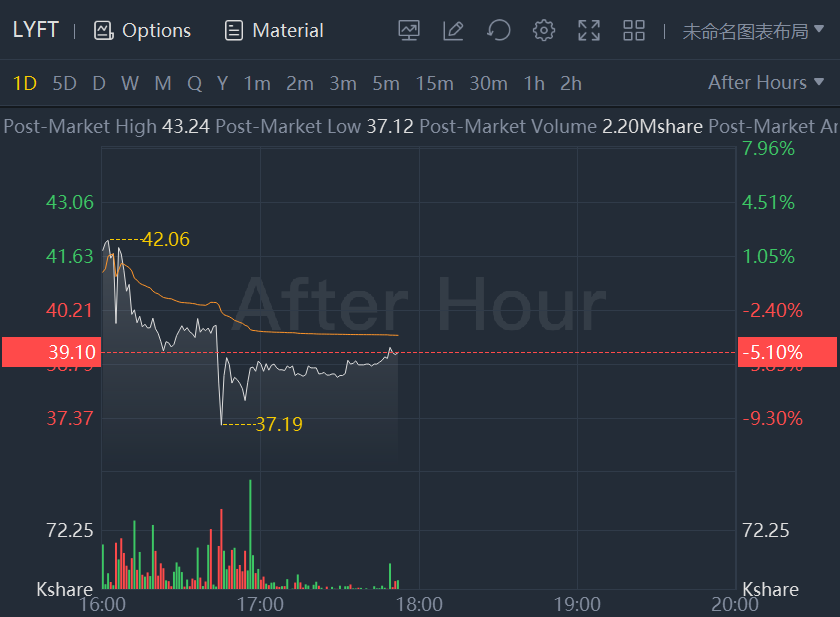Feb 8 (Reuters) - Lyft Inc missed expectations for ridership growth and said the Omicron coronavirus variant would lead to a first-quarter drop in riders compared with the end of last year, a cautious view that sent shares of the ride service down 5%.
Revenue and adjusted profit also would drop in the first quarter compared with the fourth, executives said on a call with investors.
"This outlook suggests a decline of $120 million to $170 million in revenue versus Q4," Chief Financial Officer Elaine Paul said. "We expect Q1 adjusted EBITDA will be between $5 million and $15 million versus the $75 million in Q4."
Analysts on average forecast first quarter revenue of $984 million, while Lyft's forecast $800 million-$850 million.
"Were it not for Omicron we would be projecting strong rides growth," Paul said, adding the company was seeing positive signals with mask mandates being lifted in some markets.
Lyft closed 2021 with its first full-year adjusted profit as customers eager to step out and travel paid a record amount for trips during the fourth quarter and more drivers returned to work, the ride-hailing company said on Tuesday.
Lyft reported 18.7 million active riders in the fourth quarter, compared with analyst expectations for 20.2 million riders, according to Factset.
The company reported adjusted earnings before interest, taxes, depreciation and amortization, a measure that excludes one-time costs, primarily stock-based compensation, of $74.7 million, slightly lower than the estimates of $75.59 million.
While riders continued returning to the platform compared with 2020 levels, ridership growth in the fourth quarter decreased by roughly 1% versus the prior quarter, while average revenue per rider reached the highest amount in the company's nearly 10-year history.
Lyft President John Zimmer in an interview with Reuters attributed the drop in ridership to seasonality and a less busy New Year's Eve. He said higher prices were the result of an increase in costlier airport trips.
"It appears the Omicron outbreak negatively impacted ridership. That seems to be a concern going forward," Wedbush analyst Dan Ives said.
Zimmer said the company noticed the impact of the Omicron coronavirus variant on ridership only toward the end of December, and more into January.
Revenue per active rider jumped 13.5% to an average of nearly $52 in the quarter ended Dec. 31 from the prior quarter at a time when prices in the United States for everything from toilet paper to gasoline also rose.
Lyft's fourth-quarter revenue rose 70% to $969.9 million from a year ago, beating analysts' estimates of $940.1 million, according to Refinitiv data.
Adjusted EBITDA for all of 2021 was $92.9 million, marking the first time the company achieved its profitability target on a full-year basis.
On a net basis, Lyft still lost $1 billion in 2021, although that was narrower than the $1.8 billion loss of 2020.
The 2021 net loss included $756.1 million in stock-based compensation and a roughly $250 million charge for historical insurance liabilities.
Zimmer said pricey airport rides more than doubled from the year prior.
"There was no major increase in our kind of base pricing, I think it's more stemming from a different ride mix," he said, with fewer riders commuting to work and more airport and leisure rides.
Nevertheless, Lyft never generated as much revenue per rider even in pre-pandemic times, and as customers return, Lyft and its larger rival Uber Technologies Inc discovered their surprising power to raise prices without alienating riders.
The average ride-hailing fare was about 19% higher on a per-mile basis in the fourth quarter of 2021 versus the same period in 2019 in the United States, with fares increasing by as much as 34% in Seattle and 27% in Los Angeles, according to research firm YipitData.
Zimmer said Lyft still had "plenty of headroom" before it reached pre-pandemic ridership numbers. "There is a material amount before we get back to pre-pandemic levels."
Drivers, many of whom gave up during the pandemic due to a lack of customers and safety concerns, also continued returning to the platform, Zimmer said.
"We saw much-improved conditions with drivers," he said, adding that total active drivers in the fourth quarter were up 34% year over year.
The number of new drivers who never worked for Lyft previously increased 50% on a yearly basis, Zimmer said, with the additional drivers allowing Lyft to improve its pickup times and service levels.
The ongoing work-from-home trend, particularly on the U.S. West Coast, and travel patterns shifting away from peak rush hours during the pandemic also proved beneficial, Zimmer said.
"The commute was never an ideal trip for us ... and so the fact that the commute has changed will be an opportunity for us long-term."

Comments